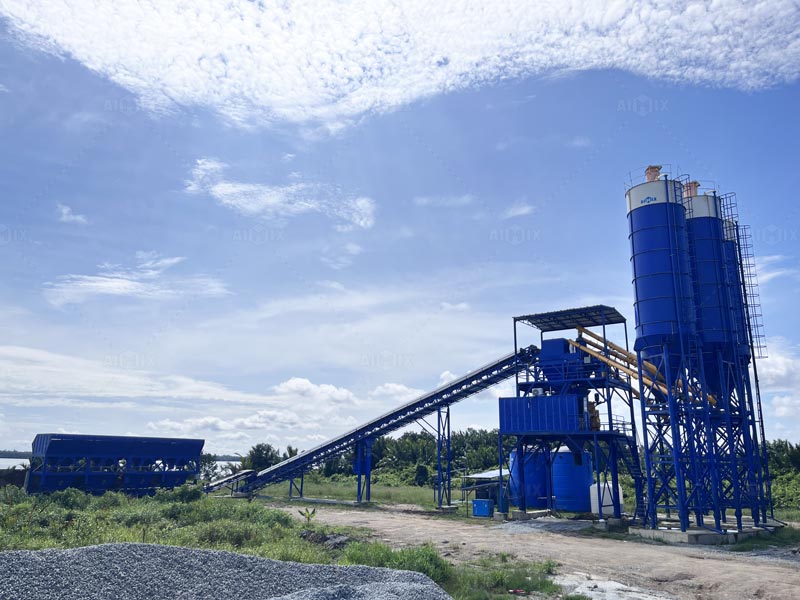Component parts of a mobile concrete plant
Contents |
[edit] Introduction
Mobile concrete plants are essential in the construction industry, offering flexibility and efficiency. These plants are particularly favoured for projects requiring mobility and rapid setup. Whether you're working on roadsides, bridges, or large-scale constructions, understanding the parts and functions of a mobile concrete plant is crucial.
[edit] What Is a Mobile Concrete Plant?
A mobile concrete plant is a type of concrete batching plant designed to be easily moved from one location to another. Unlike stationary plants, these units are portable and can produce concrete directly at construction sites. Their modular design allows quick setup and disassembly, making them ideal for temporary projects or situations requiring frequent relocations.
[edit] How Does a Mobile Concrete Plant Work?
Mobile concrete plants work by combining several components to mix and produce concrete. Each part plays a vital role in ensuring efficiency and quality in the concrete production process.
[edit] Key Components of a Mobile Concrete Plant
[edit] 1. Mixer: The Heart of the Plant
The mixer is where all ingredients—cement, aggregates, water, and admixtures—are combined to produce concrete.
- Types of Mixers: Common types include twin-shaft mixers, drum mixers, and planetary mixers.
- Importance: The mixer ensures the uniform blending of materials, which is critical for high-quality concrete production.
[edit] 2. Aggregate Bins: Storage for Raw Materials
Aggregate bins store raw materials such as sand, gravel, crushed stone, or slag. These materials are fed into the mixer via a conveyor system.
- Capacity: Aggregate bins typically hold between 20 and 80 tons of material, depending on the plant model.
- Role in Efficiency: Properly sized bins minimise refilling interruptions during production.
[edit] 3. Cement Silo: Safe Cement Storage
The cement silo stores the powdered cement used in concrete production.
- Design: Usually made of steel and featuring a conical bottom for smooth discharge.
- Capacity: Varies based on the plant’s design, ensuring a steady supply of cement during production.
[edit] 4. Water Tank: Essential for Mixing
Water is a crucial ingredient in concrete. The water tank supplies the mixer with the exact amount needed for the desired consistency.
- Location: Typically opposite the cement silo on the plant.
- Capacity and Features: Tanks may include measuring devices to ensure accurate water addition.
[edit] 5. Admixture Tanks: Enhancing Concrete Properties
Admixtures are chemicals added to concrete to modify its properties, such as strength, durability, or curing time.
- Storage: Admixture tanks store these chemicals and deliver them to the mixer in precise quantities.
- Examples of Admixtures: Accelerators, retarders, and water-reducing agents.
[edit] 6. Control Room or Control Panel: The Brain of the Plant
The control room houses the control panel, where the operator manages all plant functions.
- Functions Controlled: Mixer operation, water and admixture addition, and monitoring of the entire process.
- Automation: Many mobile plants feature advanced computerised systems for precise and efficient operation.
[edit] Advantages of Mobile Concrete Plants in Construction
[edit] 1. Flexibility
Their mobility allows them to be deployed at various job sites, reducing transportation time for concrete.
[edit] 2. Quick Setup
The modular design ensures that the plant can be assembled and disassembled rapidly.
[edit] 3. Cost Efficiency
Producing concrete on-site eliminates the need for transporting ready-mix concrete, saving time and costs.
[edit] 4. Adaptability to Different Projects
From small-scale residential projects to large infrastructure developments, mobile plants meet diverse construction needs.
[edit] Tips for Maximising Efficiency
- Regular Maintenance: Clean the mixer daily and inspect bins, silos, and tanks regularly.
- Proper Calibration: Ensure that all components, especially admixture and water tanks, are calibrated for accuracy.
- Operator Training: Equip operators with knowledge about plant functions to avoid errors and downtime.
[edit] Conclusion
Understanding the parts of your mobile concrete plant is essential for optimising its performance and ensuring consistent concrete quality. From the mixer to the control panel, each component plays a crucial role in the production process. By familiarising yourself with these elements, you’ll not only enhance efficiency but also extend the lifespan of your equipment, ensuring your construction projects run smoothly and cost-effectively.
[edit] Related articles on Designing Buildings
- Avoiding crane collapses.
- Back actor.
- Banksman.
- Bituminous mixing and laying plant.
- Central plant.
- Compact construction equipment.
- Compressed air plant.
- Concreting plant.
- Construction tools.
- Crane supports.
- Crane regulations.
- Decentralised plant.
- Earth-moving plant.
- Equipment supply.
- Excavating plant.
- Forklift truck.
- Hoists.
- How to manage construction plant.
- Lifting devices.
- Mini excavators market.
- Piling equipment.
- Plant acquisition.
- Power float.
- Pumps and dewatering equipment.
- Rubble chute.
- Tool theft.
- Types of crane.
Featured articles and news
Latest Build UK Building Safety Regime explainer published
Key elements in one short, now updated document.
UKGBC launch the UK Climate Resilience Roadmap
First guidance of its kind on direct climate impacts for the built environment and how it can adapt.
CLC Health, Safety and Wellbeing Strategy 2025
Launched by the Minister for Industry to look at fatalities on site, improving mental health and other issues.
One of the most impressive Victorian architects. Book review.
Common Assessment Standard now with building safety
New CAS update now includes mandatory building safety questions.
RTPI leader to become new CIOB Chief Executive Officer
Dr Victoria Hills MRTPI, FICE to take over after Caroline Gumble’s departure.
Social and affordable housing, a long term plan for delivery
The “Delivering a Decade of Renewal for Social and Affordable Housing” strategy sets out future path.
A change to adoptive architecture
Effects of global weather warming on architectural detailing, material choice and human interaction.
The proposed publicly owned and backed subsidiary of Homes England, to facilitate new homes.
How big is the problem and what can we do to mitigate the effects?
Overheating guidance and tools for building designers
A number of cool guides to help with the heat.
The UK's Modern Industrial Strategy: A 10 year plan
Previous consultation criticism, current key elements and general support with some persisting reservations.
Building Safety Regulator reforms
New roles, new staff and a new fast track service pave the way for a single construction regulator.
Architectural Technologist CPDs and Communications
CIAT CPD… and how you can do it!
Cooling centres and cool spaces
Managing extreme heat in cities by directing the public to places for heat stress relief and water sources.
Winter gardens: A brief history and warm variations
Extending the season with glass in different forms and terms.
Restoring Great Yarmouth's Winter Gardens
Transforming one of the least sustainable constructions imaginable.
























